Chapter 23 – Human Anatomy & Physiology (Vocabulary) – Flashcards
Unlock all answers in this set
Unlock answersquestion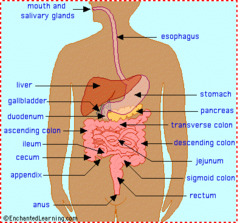
Digestive system

answer
Takes in food, breaks it down into nutrient molecules, absorbs these molecules into the bloodstream, and rids the body of the indigestible remains.
question
Alimentary canal, gastrointestinal (GI) tract or gut
answer
The continuous, muscular digestive tube that winds through the body. It digests food and absorbs the digested fragments through its lining into the blood. The organs of the alimentary canal are the mouth, pharynx, esophagus, stomach, small intestine, and large intestine.
question
Accessory digestive organs
answer
An organ that helps with digestion but is not part of the alimentary canal. The teeth, tongue, gallbladder, and a number of large digestive glands - the salivary glands, liver, and pancreas.
question
Peristalsis
answer
The major means of propulsion, involves alternate waves of contraction and relaxation of the smooth muscles in the organ walls. Its main effect is to squeeze food along the tract, but some mixing occurs as well.
question
Segmentation
answer
The rhythmic local constrictions of the small intestine. This mixes food with digestive juices and increases the efficiency of absorption by repeatedly moving different parts of the food mass over the intestinal wall.
question
Defecation
answer
Eliminates indigestible substances from the body via the anus in the form of feces.
question
Peritoneum
answer
The serous membranes of the abdominopelvic cavity. Visceral peritoneum covers the external surfaces of digestive organs. Parietal peritoneum lines the inner surface of the abdominopelvic cavity. Both membranes secrete serous fluid to reduce friction as the digestive organs glide across one another.
question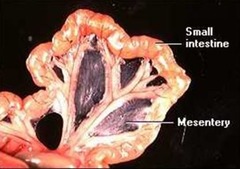
Mesentery

answer
Sturcture; A double layer of the peritoneum. Functions; 1. Provides routes for blood vessels, lymphatic vessels, and nerves to reach the digestive organs. 2. Holds digestive organs in place. 3. Stores fat.
question
Retroperitoneal organs
answer
Pertaining to organs closely attached to the posterior abdominopelvic wall and partly covered by parietal peritoneum. Organs include the esophagus, pancreas, duodenum, ascending colon, descending colon, rectum, adrenal glands, kidneys, ureters, urinary bladder, aorta, inferior vena cava, and uterus.
question
Intraperitoneal or peritoneal organs
answer
Pertaining to organs completely surrounded by the visceral peritoneum. Organs include the stomach, liver, gallbladder, jejunum, ileum, vermiform appendix, cecum, transverse colon, and sigmoid colon.
question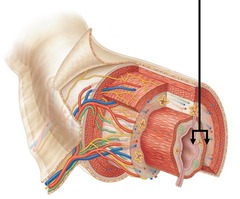
Mucosa or mucous membrane

answer
The moist inner most layer of the alimentary canal. Structure is 3 tissues; simple columnar epithelium, areolar connective tissue, and smooth muscle. Functions; 1. Secrete mucus, digestive enzymes, and hormones. 2. Absorb products of digestion into the blood. 3. Protect against infectious disease.
question
Submucosa
answer
Surrounding the mucosa. Structure is areolar connective tissue. Functions; 1. Provide a rich supply of blood vessels, lymphatic vessels, and nerve fibers to surrounding tissues. 2. Contains abundant elastic fibers allowing the alimentary canal to stretch and regain its normal shape.
question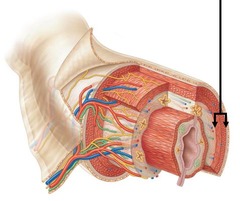
Muscularis externa or muscularis

answer
Surrounding the submucosa. Structure is an inner circular layer and an outer longitudinal layer of smooth muscle. Functions; Responsible for segmentation and peristalsis of the alimentary canal.
question
Serosa
answer
Outermost layer of the alimentary canal surrounding the muscularis externa. Also known as Visceral peritoneum. Structure is areolar connective tissue and simple squamous epithelium. Functions; 1. Protection of the internal layers. 2. Secretion of serous fluid.
question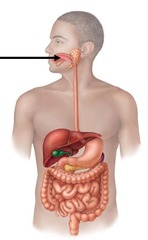
Mouth or oral cavity

answer
Structure; a mucosa-lined cavity. Its boundaries are the lips anteriorly, cheeks laterally, palate superiorly, and tongue inferiorly. Functions; 1. Allows food to enter the body. 2. Breaks the food into pieces that are more easily digested.
question
Tongue
answer
Occupies the floor of the mouth. Structure; Is composed of interlacing bundles of skeletal muscle fibers. Functions; 1. Grips food and repositions it between the teeth. 2. Mixes food with saliva.
question
Bolus
answer
Compact chewed food mixed with saliva in the mouth.
question
Saliva
answer
Watery liquid secreted into the mouth by the salivary glands. Functions; 1. Cleanses the mouth. 2. Dissolves food chemicals so they can be tasted. 3. Moistens food and aids in compacting it into a bolus. 4. Contains the enzyme salivary amylase that begins the chemical breakdown of carbohydrates.
question
Parotid gland
answer
A pair of large salivary glands situated just in front of each ear.
question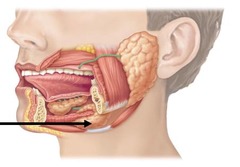
Submandibular gland

answer
A pair of salivary glands situated below the lower jaw.
question
Sublingual gland
answer
A pair of salivary glands situated in the mucus membrane on the floor of the mouth beneath the tongue.
question
Teeth
answer
Hard structures embedded in the maxilla and mandible of the skull that physically break down food by chewing and grinding.
question
Oropharynx
answer
The upper part of the pharynx that lies between the soft palate and the hyoid bone.
question
Laryngopharynx
answer
The lower part of the pharynx that lies behind or adjacent to the larynx.
question
Esophagus
answer
A muscular tube that connects the mouth to the stomach.
question
Mastication
answer
The mechanical breakdown of food in the mouth. Also known as Chewing.
question
Deglutition
answer
Also known as swallowing.
question
Stomach
answer
A muscular and elastic sac that serves mainly to store food, breaks food up mechanically, and begins chemical digestion of proteins.
question
Chyme
answer
The thick semifluid mass of partly digested food that is passed from the stomach to the duodenum of the small intestine.
question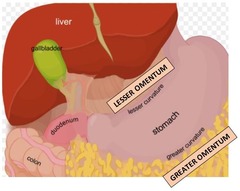
Lesser omentum

answer
A mesentery of the stomach that runs from the liver to the lesser curvature of the stomach, where it becomes continuous with the visceral peritoneum covering the stomach.
question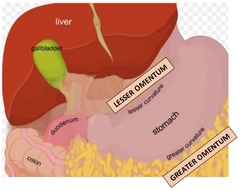
Greater omentum

answer
A mesentery of the stomach that drapes inferiorly from the greater curvature of the stomach to cover the coils of the small intestine. It is riddled with fat deposits that give it the appearance of a lacy apron.
question
Gastric juice
answer
Strongly acidic (pH 1 to 3) liquid secreted by the glands in the lining of the stomach. Composed of the digestive enzymes pepsin and rennin, hydrochloric acid, and mucus. Begins the chemical breakdown of proteins.
question
Small intestine
answer
The body's major digestive organ. Within its passageway, digestion is completed and virtually all absorption occurs. Has 3 subdivisions, the duodenum, jejunum, and ileum.
question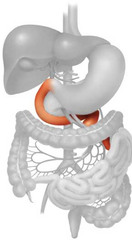
Duodenum

answer
The first subdivision of the small intestine about 25 cm long (10 inches) which receives chyme from the stomach. Many chemical secretions from the pancreas, liver and gallbladder mix with the chyme in the duodenum to facilitate chemical digestion.
question
Jejunum
answer
The middle subdivision of the small intestine about 2.5 m long (8 ft) found between the duodenum and the ileum. Most of the nutrients present in food are absorbed by the jejunum before being passed on to the ileum for further absorption.
question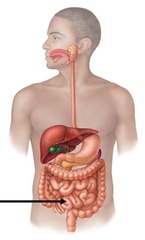
Ileum

answer
The last subdivision of the small intestine about 3.6 m long (12 ft). It is where the remaining nutrients are absorbed before moving into the large intestine.
question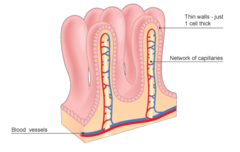
Villi

answer
Fingerlike projections over 1 mm high of the small intestine's mucosa. Gives the inside surface a velvety texture, much like the soft nap of a towel.
question
Microvilli
answer
Fingerlike projections of the simple columar epithelium's plasma membrane. These absorptive cells of the small intestine's mucosa give the surface a fuzzy appearance called the brush border.
question
Intestinal juice
answer
A fluid that is secreted in small quantities in the small intestine, is highly variable in composition, and contains various enzymes (erepsin, lipase, lactase, enterokinase, and amylase) and mucus.
question
Liver
answer
The largest gland in the body, weighing about 1.4 kg (3 lbs). Functions; 1. Digestion through the production of bile. 2. Metabolizing carbohydrate, lipids, and proteins into biologically useful materials. 3. Detoxification of the blood. 4. Storage of essential nutrients, vitamins, and minerals. 5. Production of several vital protein components of blood. 6. Immunity by removing debris such as bacteria and worn-out blood cells from the blood.
question
Bile
answer
A yellow-green, alkaline solution produced by the liver and stored in the gallbladder. Discharged into the duodenum of the small intestine when needed to aid in the emulsification of fats
question
Bilirubin
answer
The chief bile pigment. A waste product of the heme of hemoglobin formed during the breakdown of worn-out erythrocytes (red blood cells). Metabolized in the small intestine by resident bacteria. One of its breakdown products, stercobilin, gives feces a brown color.
question
Gallbladder
answer
A thin-walled green muscular sac about 10 cm (4 inches) long. Found on the ventral surface of the liver. Stores bile that is not immediately needed for digestion and concentrates it by absorbing some of its water and ions.
question
Pancreas

answer
A triangular-shaped exocrine and endocrine gland located partially behind the stomach. Digestive system function, produces an enzyme-rich juice that is carried by ducts to the duodenum of the small intestine. Endocrine system function, produces glucagon and insulin hormones.
question
Pancreatic juice
answer
Strongly basic (pH 8) liquid secreted by the pancreas to the duodenum of the small intestine. Helps neutralize acid chyme entering the duodenum from the stomach. Contains a variety of enzymes to chemically breakdown carbohydrates, proteins, fats, and nucleic acids.
question
Large intestine
answer
Its diameter, at about 7 cm (2.5 inches), is greater than that of the small intestine, but is less than half as long 1.5 m (5 ft). Functions to absorb most of the remaining water from indigestible food residues. Has 5 subdivisions, the cecum, vermiform appendix, colon, rectum, and anal canal.
question
Feces
answer
Semisolid undigested food material and other waste products that exit the body through the anus.
question
Cecum
answer
The first portion of the large intestine, which is situated in the lower-right quadrant of the abdomen. The cecum receives fecal material from the ileum, which opens into it.
question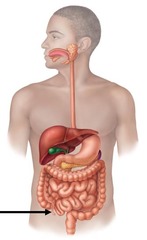
Vermiform appendix

answer
Wormlike projection of lymphatic tissue hanging off the cecum with no digestive function. It plays an important role in body immunity.
question
Ascending colon
answer
The part of the large intestine that ascends from the cecum to the transverse colon.
question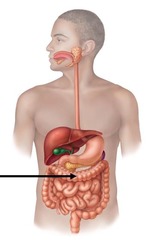
Transverse colon

answer
The part of the large intestine that extends across the abdominal cavity joining the ascending colon to the descending colon.
question
Descending colon

answer
The part of the large intestine that descends from the transverse colon to the sigmoid colon.
question
Sigmoid colon
answer
The part of the large intestine that extends from the descending colon in the pelvis to the rectum.
question
Rectum

answer
The last 15 to 20 cm (6 to 8 inches) of the large intestine. The rectum stores feces until it leaves the body through the anus.
question
Anus
answer
The opening at the end of the alimentary canal through which solid feces leaves the body.



